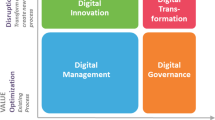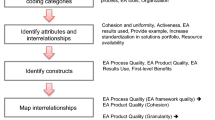Abstract
We present a curriculum that prepares students for supporting large Enterprise Information Systems (EIS). EIS is best explained through the evolution of Enterprise Resource Planning (ERP). These systems evolved over the last years driven by (1) changing business requirements and (2) new development capabilities provided by technologies evolution and software vendors’ innovation. These developments led to a new discipline—Enterprise Information Systems, which deals with issues whose focus is on creating and sustaining business benefits through the utilization of corporate IT infrastructure assets. Currently, EIS knowledge is essentially acquired on the job after substantial time of experience building and longer career ladder scale. This paper presents an experience of a curriculum implementation that prepares students for the pervasive EIS landscape in meeting today’s corporate needs. Our IT-based educational approach is evaluated as an alternative to prevailing Business-based approaches to EIS instruction. In this IT-rooted approach, the curriculum is divided into four sections: a Core IT block of courses followed by two progressive-levels of advanced EIS-related specialized subjects, and an industry-oriented field-training experience. Initially, a Core IT background provides a foundation for IT innovation in developing EIS components at sophomore-level. A junior-level of specialized instruction introduces integrated modules which form EIS platforms. Finally, supporting technologies of EIS-related processes and workflows are presented at senior-level of specialized EIS instruction. An assessment case study of the proposed Enterprise System programs is carried out through which we discuss the results of the curriculum performance.










Similar content being viewed by others
References
Al-Mashari, M. (2003). Enterprise resource planning (erp systems: A research agenda). Industrial Management and Data Systems, 103(1), 22–27.
APICS (2010). http://www.apics.org/. Retrieved on April 2010.
Brown, C. V., & Vessey, I. (2003). Managing the next wave of enterprise systems: Leveraging lessons from erp. MIS Quarterly Executive, 2(1), 1–21.
Cameron, B. H. (2008). Enterprise systems education: New directions and challenges for the future. In SIGMIS-CPR ’08: Proceedings of the 2008 ACM SIGMIS CPR conference on computer personnel doctoral consortium and research (pp. 119–126). New York: ACM.
Davenport, T. H., & Brooks, J. (2004). Enterprise systems and the supply chain. Journal of Enterprise Information Management, 17(1), 8–19.
Davies, I., & Queensland University of Technology (Eds.) (2002). Proceedings of the enterprise systems interoperability workshop. Brisbane: Queensland University of Technology.
Denning, P. J. C., Athale, R., Dabbagh, N., Menascé, D., Offutt, J., Pullen, M., et al. (2010). A model IT curriculum for the UAE University. http://cs.gmu.edu/cne/pjd/UAE/. Retrieved April 2010.
Gaß, O., & Maedche, A. (2010). Teaching the transformation from classical on-premise towards on-demand enterprise systems. In Proceedings of multikonferenz wirtschaftsinformatik (MKWI 2010).
Hendricks, K. B., Singhal, V. R., & Stratman, J. K. (2010). The impact of enterprise systems on corporate performance: A study of erp, scm, and crm system implementations. Journal of Operations Management. doi:10.1016/j.jom.2006.02.002.
Joannou, P. (2007). Enterprise, systems, and software engineering—the need for integration. IEEE Computer, 40, 103–105.
Joseph, P. M., & Lunt, B. M. (2006). It in the middle east: An overview. In SIGITE ’06: Proceedings of the 7th conference on information technology education (pp. 25–30). New York: ACM.
Lee, S. M., Olson, D. L., & Lee, S.-H. (2009). Open process and open-source enterprise systems. Enterprise Information Systems, 3(2), 201–209.
Lunt, B. M., & Ekstrom, J. J. (2008). The IT model curriculum: A status update. In SIGITE ’08: Proceedings of the 9th ACM SIGITE conference on information technology education (pp. 1–4). New York: ACM.
Markus, M. L., & Tanis, C. (2000). The enterprise systems experience-from adoption to success (pp. 173–207). Cincinnati, OH: Pinnaflex Education Resources, Inc.
Møller, C., Kræmmergaard, P., & Rikhardsson, P. (2000). What is erp? Information Systems Frontiers, 2(2), 141–162.
Møller, C., Kræmmergaard, P., & Rikhardsson, P. (2006). The emergence of enterprise systems management—a challenge to the is curriculum. Informatics Research Group working papers I-2005-03, University of Aarhus, Aarhus School of Business, Department of Business Studies. http://econpapers.repec.org/RePEc:hhb:aarbin:2005-003.
Monk, E., & Wagner, B. (2005). Concepts in enterprise resource planning (2nd ed.). Course Technology.
Nah, F. F., & Lau, J. L. (2001). Critical factors of successful implementation of enterprise systems. Business Process Management Journal, 7(3), 285–296.
Rosemann, A. D. M., & Sadiq, W. (2005). Model driven process configuration of enterprise systems. In Proceedings of the 7th international tagung wirtschaftsinformatik. Gesellschaft für informatik (pp. 687–706). Physica.
Shang, S., & Seddon, P. (2004). Enterprise systems benefits: How should they be assessed? In Proceedings Pacific Asia conference on information systems (PACIS). Shanghai, China.
Wreder, K., & Deng, Y. (1999). Architecture-centered enterprise system development and integration based on distributed object technology standard. In Computer software and applications conference (p. 250).
Author information
Authors and Affiliations
Corresponding author
Appendix: Catalog description of major ES courses
Appendix: Catalog description of major ES courses
Courses | Brief catalogue description |
|---|---|
ITBP312 | Functions of a database system (tables, relations, relational operations, queries, views) and the OS support needed to implement them; functions of information retrieval system; accessing organizational data and external data; security and access control; secure intranets; user interface; macro programming; running web and other information services from a database; E-commerce basics; webclients, servers, and search engines; examples of major commercial systems |
ISBP301 | Transforming typical manual business operations into an evolving electronic enterprise. Fundamental concepts on various core business functional operations. Potential IT architecture and capabilities to support such functional objectives. Elementary strategies to align IT to business needs via standard IS applications to support basic to complex and evolving enterprise. Enterprise management e-services incorporating elementary concepts on information portals including e-commerce, e-business, e-procurement, e-finance and e-audit. Advancement in mobile technology and its application to e-enterprise |
ISBP350 | Technology and architecture, implementing integrated package solutions. The ERP framework, tools and functionality of leading enterprise systems, ERP procurement, ERP Vendors (Microsoft Dynamic Great Plain), implementation cases, supply-chain management |
ISBP420 | Information systems design and implementation within a database management systems environment; student project is to construct a system; data models; modeling tools and techniques; structured and object design approaches; relational, hierarchical, networked, and object oriented database models; CASE tools; data dictionaries, repositories, warehouses; client-server planning, testing, and installation; system conversion, end-user training and post implementation review |
IBSP450 | Main topics include establishing DM structures, organizational issues, association rules, decision trees, neural networks, clustering, sequence similarity, data preparation, data warehousing |
ISBP440 | Successful management of system development or enhancement projects for enterprise-level systems; managing the system life cycle; requirements determination, logical design, physical design, testing, and implementation; system and database integration; network and client-server management; metrics for project management and system performance evaluation; managing expectations of superiors, users, team members,and others related to the project; determining skill requirements and staffing the project; analysis of cost-effectiveness; reporting and presentation; managing both the behavioral and technical aspects of the project; change management |
ISBP450 | Main topics include establishing DM structures, organizational issues, association rules, decision trees, neural networks, clustering, sequencesimilarity, data preparation, data warehousing |
Rights and permissions
About this article
Cite this article
Atif, Y., Al-Jaroodi, J., Alkobaisi, S. et al. Enterprise Systems: Curriculum design and assessment. Educ Inf Technol 16, 441–461 (2011). https://doi.org/10.1007/s10639-010-9138-4
Published:
Issue Date:
DOI: https://doi.org/10.1007/s10639-010-9138-4




